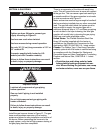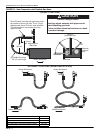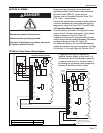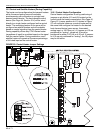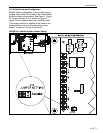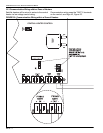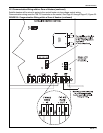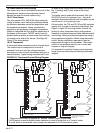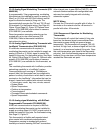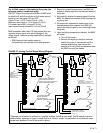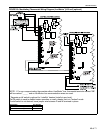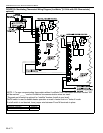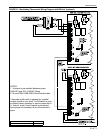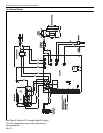
SECTION 10: WIRING
45 of 71
10.4.3 Analog Signal Modulating Thermostat (P/N
90425105)
A programmable, 7-day programming, modulating
thermostat can be installed to supply an analog (4-
20mA) or (2-10Vdc with 500 Ohm resistor) control
signal to dictate the heater(s) firing rate. The
thermostat shall energize the T24 and T25 (R and
W) terminals. For thermostat wiring, See Page 49,
Figure 29 and Page 50, Figure 30. Optional room
sensors (P/N 10081520) and outdoor air sensors
(P/N 10081521) are available.
Room temperature averaging networks can be
created with up to nine room sensors (P/N
10081520). Refer to thermostat installation
instructions for wiring.
10.4.4 Analog Signal Modulating Thermostat with
LonWorks
®
Communication (P/N 90425104)
If LonWorks
®
communication is required, a
modulating thermostat can be installed to supply an
analog (4-20mA or 2-10Vdc) signal to control the
heater(s) firing rate. For thermostat wiring, See Page
49, Figure 29 and Page 50, Figure 30. Optional room
sensors (P/N 10081520) and outdoor air sensors
(P/N 10081521) are available for this thermostat, as
well.
The modulating thermostat with LonWorks
®
provides
networking capability in a LonWorks
®
system.
Communications port running at 78 kilobits per
second (kbs), this thermostat can be configured to
perform a variety of activities in which data is sent or
received on the LonWorks
®
. Information that can be
shared, viewed and modified with network includes:
• Current year, month, day, hour, minute, second.
• System Mode.
• Space Temperature
• Outdoor air temperature
• Current setpoint
• Occupied/Unoccupied schedule commands.
• Space Temperature
10.4.5 Analog signal Modulating with BACnet
®
Programmable Thermostat (P/N 90425109).
If BACnet
®
communication is required, a BACnet
®
enabled modulating thermostat can be installed to
supply an analog output (0-10VDC) signal control to
dictate the heater(s) firing rate. For thermostat wiring,
See Page 51, Figure 31.
This thermostat is a flexible wall-mounted stand-
alone control with combined controller/sensor.
Temperature sensing is standard with optional
humidity and motion sensing. BACnet
®
connections
allow integral peer to peer BACnet
®
MS/TP LAN
network communications with configurable baud
rates and can easily integrate with a building
automation system.
MS/TP Wiring
Connect the -A terminal in parallel with all other -A
terminals on the network and the +B terminal in
parallel with other +B terminals.
10.4.6 Sequence of Operation for Modulating
Thermostats
The thermostat will control the heater(s) firing rate
based on the demand signal communicated from
thermostat program taking into account space
temperature. The thermostat will energize T25 (W)
terminal. At high heat, a demand signal will turn the
heater(s) on at maximum heater(s) firing rate. Once
the room temperature gets close to the thermostat
set point, then the thermostat program will slow the
heater(s) firing rate down until the room temperature
reaches the thermostat set point.



